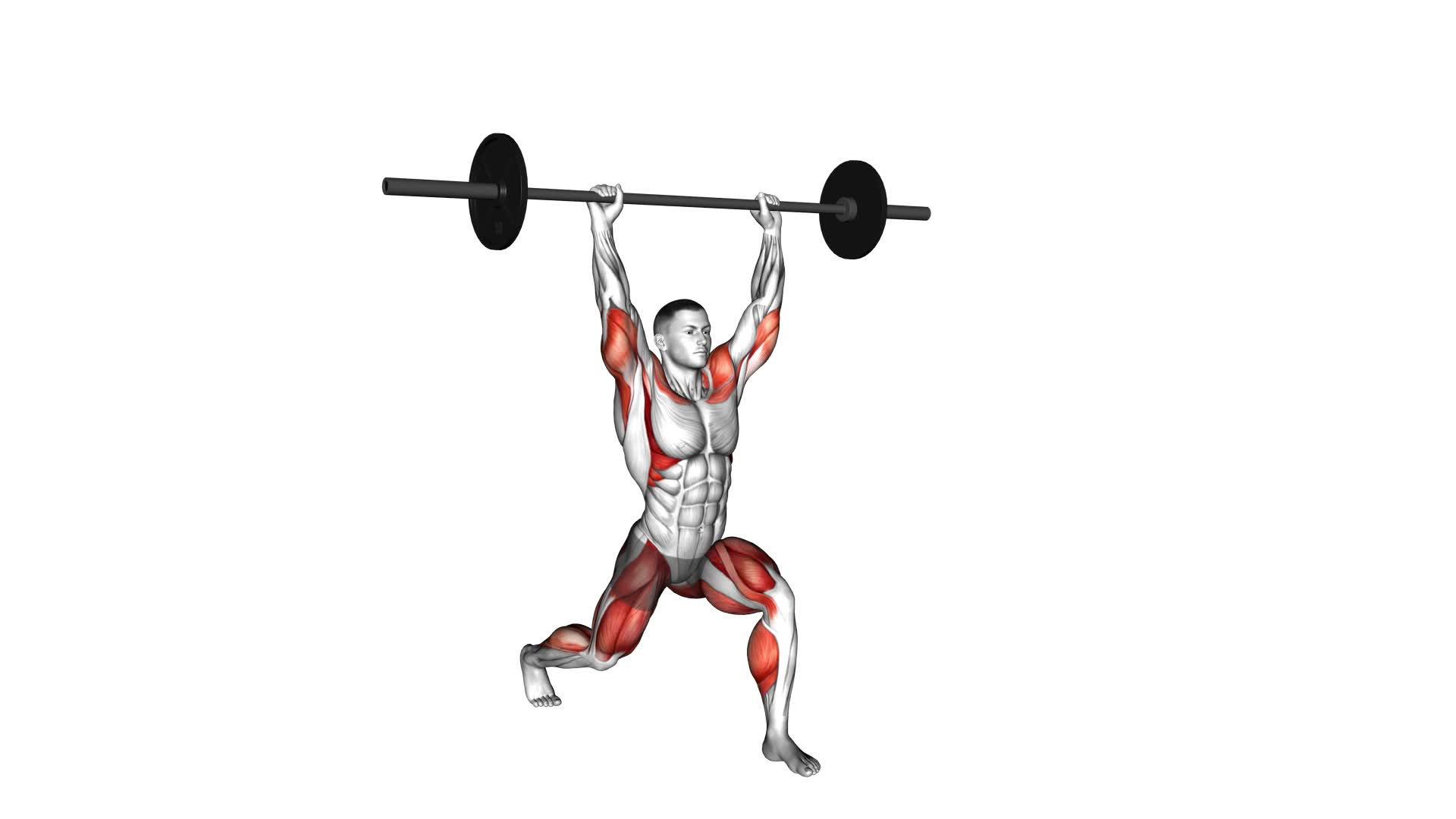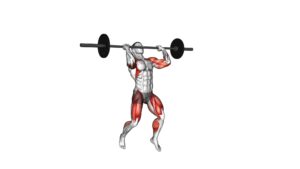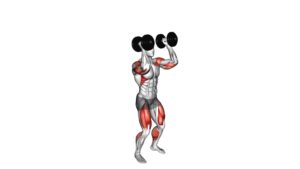Barbell Split Jerk – Video Exercise Guide & Tips

Are you looking to improve your split jerk technique?
Watch This Exercise Video
In this article, you'll find a video exercise guide and helpful tips for the barbell split jerk.
Learn about the benefits of this exercise, along with proper set-up, grip, and execution techniques.
We'll also cover common mistakes and how to fix them, as well as progression exercises to enhance your split jerk strength and stability.
Get ready to elevate your performance with the barbell split jerk!
Key Takeaways
- The barbell split jerk maximizes strength and stability while targeting multiple muscle groups simultaneously.
- It increases power and improves balance by engaging the legs, core, and back muscles.
- Proper set-up and grip include positioning the barbell at shoulder height and experimenting with grip width for optimal stability and control.
- Technique breakdown and execution involve starting with feet hip-width apart, jumping and splitting legs into a lunge position, explosively extending hips, maintaining a vertical bar path, and ensuring front foot stability and back foot positioning.
Benefits of the Barbell Split Jerk
By performing the barbell split jerk, you can maximize your strength and stability while targeting multiple muscle groups simultaneously. This explosive exercise is highly effective in increasing power and improving balance.
The barbell split jerk primarily engages the legs, particularly the quadriceps, hamstrings, and glutes, to generate the necessary force to lift the barbell overhead. This movement also activates the core muscles, including the abdominals and lower back, to provide stability and control throughout the exercise.
The split jerk requires you to split your legs into a forward lunge position, with one foot in front and the other behind. This stance not only challenges your balance but also requires coordination and proprioception to execute the movement correctly. As a result, regular practice of the barbell split jerk can lead to improved balance and body awareness.
Furthermore, the explosive nature of the barbell split jerk helps to develop power in the lower body. The rapid extension of the hips and explosive drive from the legs allow you to generate significant force to lift the barbell overhead. This translates to increased power, which can be beneficial for various athletic activities and sports that require explosive movements.
Proper Set-up and Grip
To properly set up and grip for the barbell split jerk, position yourself with the barbell at shoulder height and your hands slightly wider than shoulder-width apart. This setup allows for optimal stability and control during the exercise.
It's important to note that there are a few common misconceptions when it comes to the proper grip for the split jerk. Some people mistakenly believe that a wider grip will provide more power, but this can actually limit your range of motion and decrease your ability to generate force. On the other hand, gripping the bar too narrow can make it difficult to maintain balance and stability. It's important to find a grip that's comfortable for you, but also allows for proper execution of the movement.
Additionally, variations and modifications can be made to accommodate individual preferences and needs. For example, some athletes may prefer a slightly narrower or wider grip based on their body proportions or mobility limitations. It's important to experiment with different grip widths and find what works best for you.
With the proper set-up and grip, you'll be ready to move on to the next section on technique breakdown and execution.
Technique Breakdown and Execution
Now that you have properly set up and gripped the barbell for the split jerk, it's time to focus on the technique breakdown and execution of the exercise. To ensure a successful split jerk, pay attention to the following:
- Split jerk footwork: Start with your feet hip-width apart and your toes pointed slightly outward. As you initiate the movement, jump and split your legs into a lunge position, with one foot forward and the other foot back. This wide stance provides a stable base for the lift.
- Hip drive in the split jerk: To generate power, explosively extend your hips and drive the barbell upward. This upward force is crucial for properly executing the split jerk and allows for greater control and stability throughout the movement.
- Maintain a vertical bar path: As you drive the barbell up, ensure that it stays in a straight line. Avoid any lateral movement that may throw off your balance and compromise your technique.
- Front foot stability: The front foot should remain flat on the ground, providing a solid foundation. This stability allows for a smooth transition and efficient transfer of force from the lower body to the upper body.
- Back foot positioning: The back foot should be on the balls of the feet, with the heel slightly elevated. This position helps maintain balance and allows for a quick recovery after the split.
Common Mistakes and How to Fix Them
As you continue to focus on the technique breakdown and execution of the barbell split jerk, it's important to be aware of common mistakes and how to fix them.
One common misconception about the barbell split jerk is that you need to jump and land with excessive force. This can put unnecessary strain on your joints and increase the risk of injury. To avoid this, focus on a controlled and smooth landing, using your legs to absorb the impact.
Another mistake to watch out for isn't fully extending your arms overhead during the jerk. This can lead to instability and decreased power output. To fix this, make sure to fully lock out your arms at the top of the movement, with your shoulders active and engaged.
In terms of injury prevention, it's crucial to maintain proper alignment throughout the lift. One common error is allowing the knees to collapse inward during the split. This can strain the knee joint and increase the risk of injury. To avoid this, focus on driving your knees outward and maintaining a stable position throughout the movement.
Additionally, it's important to avoid excessive forward or backward movement of the barbell during the split jerk. This can put strain on your back and lead to injury. To prevent this, focus on keeping the barbell directly overhead and in line with your body throughout the lift.
Progression Exercises to Improve Split Jerk Strength and Stability
To improve your split jerk strength and stability, you can incorporate progression exercises into your training routine. These exercises will help you develop the necessary strength and stability required for a successful split jerk. Here are some key exercises to include:
- Split Jerk Variations: Incorporate variations of the split jerk, such as the push jerk or the power jerk, into your training. These variations will challenge your muscles in different ways, helping you build strength and stability in the split jerk movement.
- Front Rack Lunges: Perform lunges with the barbell in the front rack position to improve your stability and balance. This exercise will also strengthen your legs, which are crucial for a powerful split jerk.
- Overhead Squats: Practice overhead squats to improve your mobility and stability in the overhead position. This exercise will help you develop the necessary flexibility and strength in your shoulders and upper back.
- Split Stance Press: Perform a split stance press to improve your stability and strength in the split position. This exercise will also target your shoulders and triceps, which are important for a strong split jerk.
- Ankle Mobility Exercises: Focus on improving ankle mobility through exercises like ankle circles and calf stretches. Good ankle mobility is essential for a stable split jerk position.
Frequently Asked Questions
How Many Sets and Reps Should I Do When Performing the Barbell Split Jerk?
When performing the barbell split jerk, it's important to consider the number of sets and reps. To determine this, you should focus on your training goals and current fitness level.
Generally, a good starting point is 3-4 sets of 6-8 reps. This will allow you to work on your technique and build strength.
Remember to maintain proper form throughout the exercise and avoid common mistakes such as not fully extending your arms or not splitting your feet wide enough.
Can the Barbell Split Jerk Be Modified for Individuals With Limited Mobility or Injuries?
If you have limited mobility or injuries, modifications can be made to the barbell split jerk. There are various ways to adapt the exercise to suit your needs.
For limited mobility, you can focus on improving flexibility and range of motion through targeted stretches and mobility exercises.
Injury prevention strategies like proper warm-up, using lighter weights, and maintaining good form can also help minimize the risk of further injury.
Consult with a fitness professional for personalized modifications.
What Are Some Alternative Exercises That Can Be Done to Complement the Barbell Split Jerk?
If you're looking for alternative exercises to complement the barbell split jerk, there are a few options to consider.
One option is the dumbbell split jerk, which can help you work on stability and coordination.
Another option is the push press, which focuses on building upper body strength.
Additionally, you can try the kettlebell split jerk, which adds an extra challenge to your balance and core stability.
These exercises can help you improve your overall performance in the barbell split jerk.
How Long Does It Typically Take to See Improvements in Split Jerk Strength and Stability?
Typically, how long does it take to see improvements in split jerk strength and stability?
Well, the improvement timeline can vary depending on factors like your training intensity and consistency. However, with dedicated practice and proper technique, you can start noticing progress in a matter of weeks.
It's important to gradually increase the weight and challenge yourself to improve your form and stability over time.
Are There Any Specific Warm-Up Exercises or Stretches That Should Be Done Before Attempting the Barbell Split Jerk?
Before attempting the barbell split jerk, it's important to warm up properly. Start with dynamic stretches like leg swings and arm circles to increase blood flow and loosen up your muscles.
Next, focus on practicing the proper technique with lighter weights, gradually increasing the load. If you have any injuries, make sure to modify the exercise accordingly.
Tracking your progress and avoiding common mistakes like incorrect foot positioning or not fully extending your arms will help you improve your split jerk form.
Conclusion
In conclusion, the barbell split jerk is a highly effective exercise for improving strength and stability. By following proper set-up, grip, and technique, you can optimize your performance and minimize mistakes.
Additionally, incorporating progression exercises can help you further enhance your split jerk abilities.
With practice and focus, you can confidently execute this exercise and reap its benefits for your overall fitness and athletic performance.

Author
Years ago, the spark of my life’s passion ignited in my mind the moment I stepped into the local gym for the first time. The inaugural bead of perspiration, the initial endeavor, the very first surge of endorphins, and a sense of pride that washed over me post-workout marked the beginning of my deep-seated interest in strength sports, fitness, and sports nutrition. This very curiosity blossomed rapidly into a profound fascination, propelling me to earn a Master’s degree in Physical Education from the Academy of Physical Education in Krakow, followed by a Sports Manager diploma from the Jagiellonian University. My journey of growth led me to gain more specialized qualifications, such as being a certified personal trainer with a focus on sports dietetics, a lifeguard, and an instructor for wellness and corrective gymnastics. Theoretical knowledge paired seamlessly with practical experience, reinforcing my belief that the transformation of individuals under my guidance was also a reflection of my personal growth. This belief holds true even today. Each day, I strive to push the boundaries and explore new realms. These realms gently elevate me to greater heights. The unique combination of passion for my field and the continuous quest for growth fuels my drive to break new ground.







